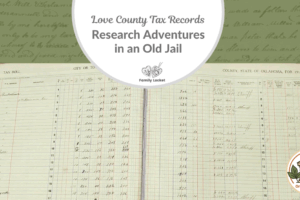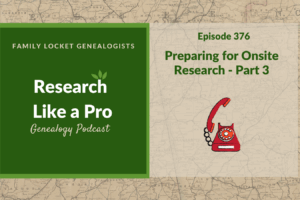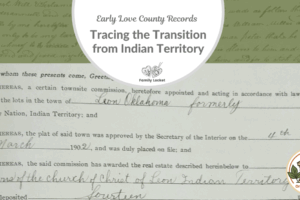In our digital age, when millions of records are accessible from our home computers, it’s easy to forget that some of our most valuable genealogical treasures still lie waiting in courthouse basements, archive storage rooms, and historical society filing cabinets. While online databases have revolutionized family history research, the reality is that countless records remain undigitized—and these might hold the keys to our most challenging research questions.
Claude (an artificial intelligence tool) helped write this blog post.
I’ll be honest—I’m a relative beginner when it comes to onsite research facilities. But in the last year, I’ve thrown myself into learning this crucial skill to achieve reasonably exhaustive research for the Kinship Determination Project (KDP) in my BCG Certification portfolio. The experiences have been both eye-opening and incredibly rewarding. My recent travels have taken me to the Love County, Oklahoma courthouse and Love County Historical Society for my KDP, and then in conjunction with the recent National Genealogical Society (NGS) Conference, I visited the Kentucky Historical Society (Thomas D. Clark Center for Kentucky History in Frankfort) and the Kentucky Department of Library and Archives.
Also, I recently took my children to the Brigham Young University Special Collections where my children and I got to see our ancestor’s 1858 diary in person!
Over the years, I’ve also visited other facilities including the FamilySearch Library, my local FamilySearch Center, the Daughters of the Utah Pioneers library in Salt Lake City, the Church History Library in Salt Lake City, and the Thomas Balch Library for history and genealogy in Leesburg, Virginia. I’ve also discovered the value of hiring researchers and working with repositories remotely. For my KDP, I hired researchers to retrieve records at the National Archives, California State Archives, Texas State Library and Archives, and the Las Animas County, Colorado courthouse on my behalf. I’ve reached out directly to county clerks—like the helpful staff at Lampasas County, Texas, who sent me exactly the records I needed.
This combination of hands-on experience and remote collaboration has taught me valuable lessons about when to travel yourself versus when to hire local expertise. Some trips exceeded my expectations—like uncovering multiple relevant deeds and tax records in Love County that painted a complete picture of my ancestor’s financial life. Others didn’t go as planned—like when I spent several hours planning for a research trip and tour at the Kentucky Department of Library and Archives as part of the NGS Conference, only to find out that the staff wasn’t planning to retrieve original records that day. I learned a valuable lesson about preparation and communication. On the bright side, I was able to use their onsite-only court records index to find potential case files to order later!
Whether you’re hitting a brick wall with online resources, need to access records that simply aren’t digitized, or want to dive deeper into local collections that might hold unexpected treasures, onsite research is a valuable part of your genealogy experience. But successful repository visits require more than just showing up with a notebook and hoping for the best.
What You’ll Learn in This Series
This multi-part series will guide you through every aspect of onsite genealogy research, from initial planning to maximizing your discoveries. Each post focuses on one specific, actionable tip that you can immediately apply to your onsite research.
We’ll start with essential preparation strategies—like the preparation phone call that can make or break your research trip and how to decode the complex indexing systems you’ll encounter at different facilities. You’ll learn practical skills for working in various repository types, from courthouse basements to state archives, including what to pack, how to handle photography restrictions, and how to structure multi-day research trips for maximum efficiency.
The series also covers problem-solving strategies for when things don’t go as planned, communication techniques that actually get results, and advanced approaches like building research networks and following up effectively after your visit. Throughout, you’ll discover how to make the most of different facility types—from courthouses with their informal atmosphere to state archives with their formal procedures, plus the hidden treasures often found in local historical societies.
Ready to Take Your Research Beyond the Screen?
Each post in this series draws from real experiences—both successful discoveries and valuable learning opportunities—as I share what I’ve learned during my own onsite research journey. You’ll discover not just what works, but what can go wrong and how to handle unexpected challenges with grace and productivity.
Whether you’re planning your first courthouse visit or, like me, looking to build confidence and optimize your repository research strategies, this series will help you approach your onsite research adventures with better preparation and realistic expectations.
The next post in the series will be about preparation. Successful onsite research requires thorough preparation before you ever step foot in a courthouse or archive. Start with a focused research objective connecting a specific ancestor to your target location, then create a detailed timeline of when they lived there to avoid wasting time on irrelevant records. Research the locality’s formation dates and previous jurisdictions, identify which record collections exist and where they’re housed, and review the facility’s online catalog and procedures. Most importantly, always call ahead to verify hours, check for closures, and understand their research protocols—this simple step can save you from disappointment and help you make the most of your limited research time.
Have you had onsite research experiences you’d like to share? I’d love to hear about your adventures—both the triumphs and the learning experiences—in the comments below!
AI Disclosure: I gave Claude.ai a transcript of an office hours session where I had taught about onsite research. Claude helped write some of the paragraphs in this blog post from the ideas I presented in that session.


















1 Comment
Leave your reply.